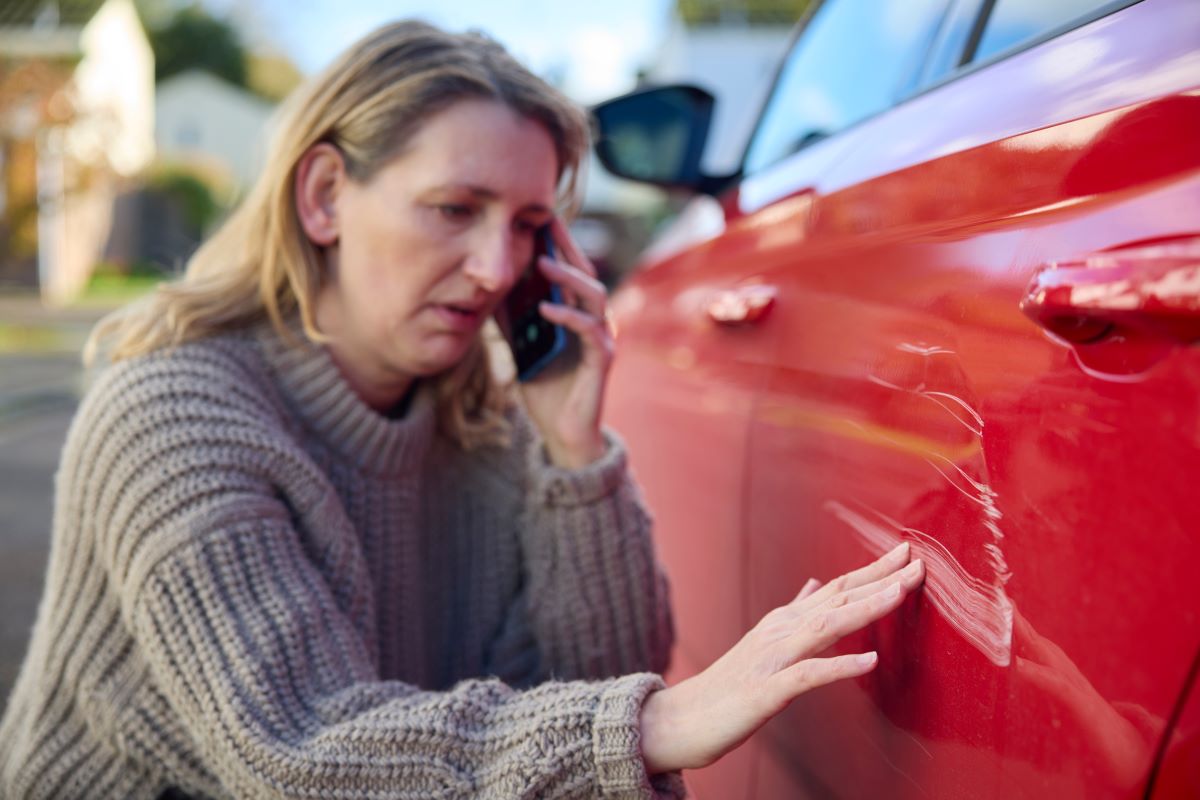Does Car Insurance Cover Scratches and Dents?

Key Takeaways:
- Whether your vehicle insurance covers scratches and dents depends on the type of coverage you have. Comprehensive insurance typically covers damage caused by events like vandalism or natural disasters, while collision insurance covers damage resulting from accidents.
- When filing a claim for scratches and dents, it’s important to consider your deductible. If the cost of repairs is close to or less than your deductible, it may not be worth filing a claim.
- Normal wear and tear or cosmetic damage that doesn’t affect the vehicle’s functionality might not be covered by insurance.
We’ve all thought about it—our car gets a mysterious dent or scratch, but rather than pay to have it fixed, we consider filing an insurance claim with our auto insurance carrier. Surely it won’t count against us or raise our premiums, right? Not so fast—be sure you know the facts before you open that claim!
When it comes to car ownership, scratches and dents are almost inevitable. Whether it’s a stray shopping cart, a minor fender bender, or an errant rock on the highway, these small damages can be frustrating and costly to repair. One of the most common questions car owners ask is, “Does car insurance cover scratches and dents?”
To answer that question, it’s important to understand the nuances of car insurance, the types of coverage available, and how these relate to cosmetic damage. We also need to delve into the process of making insurance claims for minor damages and learn more about how to avoid scratches and dents in the first place.
Understanding Car Insurance Coverage for Cosmetic Damage
Car insurance policies can be complex, and understanding what is covered under your policy is crucial. When it comes to scratches and dents, the type of coverage you have will largely determine whether these minor damages are covered.
First, let’s understand the basic types of coverage available to vehicle owners:
- Comprehensive Coverage – Comprehensive insurance is designed to cover damages to your car that are not caused by a collision. This includes theft, vandalism, natural disasters, and yes, even those annoying scratches and dents. If your car gets scratched in a parking lot or dented by a falling tree branch, comprehensive coverage will typically pay for the repairs after you’ve paid your deductible.
- Collision Coverage – Collision insurance covers damages to your car resulting from an accident with another vehicle or an object, like a fence or a pole. If the scratches or dents are the result of a collision, your collision coverage will kick in. Again, this is after you pay your deductible.
- Liability Coverage – Liability insurance is mandatory in most states and covers damages you cause to other people’s property and injuries you cause to others in an accident. However, it does not cover damages to your own vehicle. If your car gets scratched or dented in an incident where you are at fault, you will need collision or comprehensive coverage to pay for the repairs.
Understanding these distinctions is crucial because many drivers opt for only the minimum required liability insurance, which won’t cover scratches and dents on their own vehicle. It’s important to evaluate your needs and consider adding comprehensive and collision coverage if you want protection against cosmetic damage.
Pro Note: If you are financing or leasing your vehicle, your finance company or leasing company will require you to carry both Collision and Comprehensive Coverage to protect their investment as long as they have a vested interest in the property.
Weighing the Options
When faced with minor car damage, drivers often consider two options of 1) paying for repairs out-of-pocket, versus 2) filing an insurance claim.
Opting to pay out-of-pocket can be advantageous for minor repairs because it typically avoids the potential increase in insurance premiums that can accompany a claim. It also allows for quicker resolution without the need for extensive paperwork or communication with insurance adjusters.
On the other hand, filing an insurance claim can provide financial relief for more costly repairs, ensuring that the driver is not burdened with a significant upfront expense. However, this route can lead to higher future premiums and may involve deductibles, making it a less appealing option for minor damages that can be economically managed without insurance intervention.
The Impact of Minor Damage Claims on Your Insurance Premiums
Filing an insurance claim for minor damages like scratches and dents can have an impact on your insurance premiums. While it might seem logical to use your insurance to cover all repairs, doing so can sometimes result in higher costs overall, including:
- Claim Frequency – Insurance companies often consider the frequency of claims when determining your premium. If you file multiple claims, even for minor damages, it could signal to your insurer that you are at a higher risk, leading to an increase in your premium.
- Claim Amount – The amount of your claim can also affect your premium. Small claims might not have a significant impact, but larger claims can result in noticeable increases. It’s essential to weigh the cost of the repair against the potential increase in your premium before deciding to file a claim.
- No-Claim Discount – Many insurance companies offer a no-claim discount, which rewards you with a reduction on your premium if you go a certain period without filing a claim. Filing a claim for minor damages could result in the loss of this discount, making it more expensive in the long run.
- Deductible Considerations – Your deductible is your share, or the amount you pay out of pocket, before your insurance covers the rest. If the cost of repairing the scratches or dents is close to or less than your deductible, it might make more sense to pay for the repairs yourself rather than filing a claim.
Understanding these factors can help you make more informed decisions about when to use your insurance and when to cover repairs out of pocket. It’s always a good idea to discuss your options with your insurance agent to ensure you are making the best choice for your situation.
The Process of Filing an Insurance Claim for Scratches and Dents
Should you decide, it will be beneficial to file a claim for the damage, here’s a step-by-step guide to help you navigate the process:
- Assess the Damage – Before you file a claim, take a close look at the scratches or dents. Determine if the damage is minor or severe enough to warrant an insurance claim. In some cases, the cost of repairs might be less than your deductible, making a claim unnecessary.
- Document the Damage – Take clear, detailed photos of the damage. This documentation will be crucial when you file your claim and could help expedite the process.
- Contact Your Insurance Company – Report the damage to your insurance provider as soon as possible. They will guide you through the process of filing a claim. Be prepared to provide details about the incident, including when and where it occurred.
- Get an Estimate – Your insurance company may require you to get an estimate from a repair shop (or three). Some insurers have preferred repair facilities that they recommend, while others allow you to choose your own.
- Pay the Deductible – If the claim is approved, you will need to pay your deductible before the insurance company covers the remaining cost of the repairs.
- Repair the Vehicle – Once the claim is processed and approved, you can proceed with the repairs. Ensure that the repair shop provides you with a detailed invoice to submit to your insurance company if needed.
How to Avoid Scratches and Dents
Prevention is always better than cure, and this certainly applies to scratches and dents on your car. While it’s impossible to avoid every potential hazard, there are several steps you can take to minimize the risk of cosmetic damage to your vehicle.
- Parking Strategies – One of the most common places for scratches and dents to occur is in parking lots. When parking, try to choose a spot that’s away from other cars if possible. Look for end spots or areas with fewer vehicles. Avoid parking next to cars that are parked at an angle or look like they might not have been parked carefully.
- Protective Measures – Consider investing in car accessories that can help protect your vehicle. Car covers can protect against scratches caused by debris or animals. Bumper guards and door protectors can also minimize the risk of dents and scratches from other vehicles.
- Careful Driving – Being cautious while driving can also help you avoid scratches and dents. Pay attention to road conditions and avoid driving too close to bushes, trees, or other objects that could scratch your car. Be mindful of how you maneuver in tight spaces, such as parking garages or narrow streets.
- Regular Maintenance – Keeping your car in good condition can also help prevent cosmetic damage. Regularly washing and waxing your car can remove dirt and debris that could scratch the paint. It also creates a protective layer that can help prevent minor scratches from turning into more significant damage.
- Mindful Loading and Unloading – Be careful when loading and unloading items from your car. Avoid placing sharp or heavy objects on your vehicle’s exterior. Use protective mats or blankets to prevent scratches when transporting large items.
By taking these preventive measures, you can reduce the likelihood of scratches and dents on your car, ultimately saving you time and money on repairs.
The Importance of Comprehensive Auto Insurance
While taking preventive measures can help, having comprehensive auto insurance is essential for protecting your investment in your vehicle. Comprehensive coverage not only provides peace of mind but also ensures that you are financially protected against a wide range of potential damages, including scratches and dents.
- Financial Protection – Comprehensive insurance protects you from out-of-pocket expenses for repairs due to non-collision-related damages. Whether it’s vandalism, weather-related damage, or accidental scratches, having comprehensive coverage can save you from unexpected repair costs.
- Resale Value – Keeping your car in good condition is essential for maintaining its resale value. Comprehensive coverage can help you address cosmetic damage promptly, ensuring that your car remains in excellent condition. This can be particularly important if you plan to sell or trade in your vehicle in the future.
- Peace of Mind – Knowing that you have coverage for a wide range of potential damages can provide peace of mind. You won’t have to worry about the financial implications of minor accidents or unexpected events, allowing you to enjoy driving your car without unnecessary stress.
- Holistic Protection – Comprehensive coverage is part of a broader auto insurance plan that includes liability and collision coverage. Together, these types of coverage provide holistic protection for your vehicle, ensuring that you are covered in a wide range of scenarios.
To Sum Up
In conclusion, understanding your car insurance policy and the coverage it provides for scratches and dents is essential. While preventive measures can help, having comprehensive auto insurance is crucial for protecting your investment and providing peace of mind. By making informed decisions about your coverage and knowing when to file a claim, you can ensure that your car remains in excellent condition without unnecessary financial strain.
By following these guidelines and understanding the intricacies of car insurance, you can be better prepared to handle minor damages and maintain your vehicle’s appearance and value. Whether you’re dealing with a minor scratch or a significant dent, knowing your insurance options and taking proactive steps can make all the difference.
Learn more at einsurance.com and obtain a quote for the best pricing from highly reputable national insurance carriers.

 EINSURANCE
EINSURANCE EINSURANCE
EINSURANCE EINSURANCE
EINSURANCE